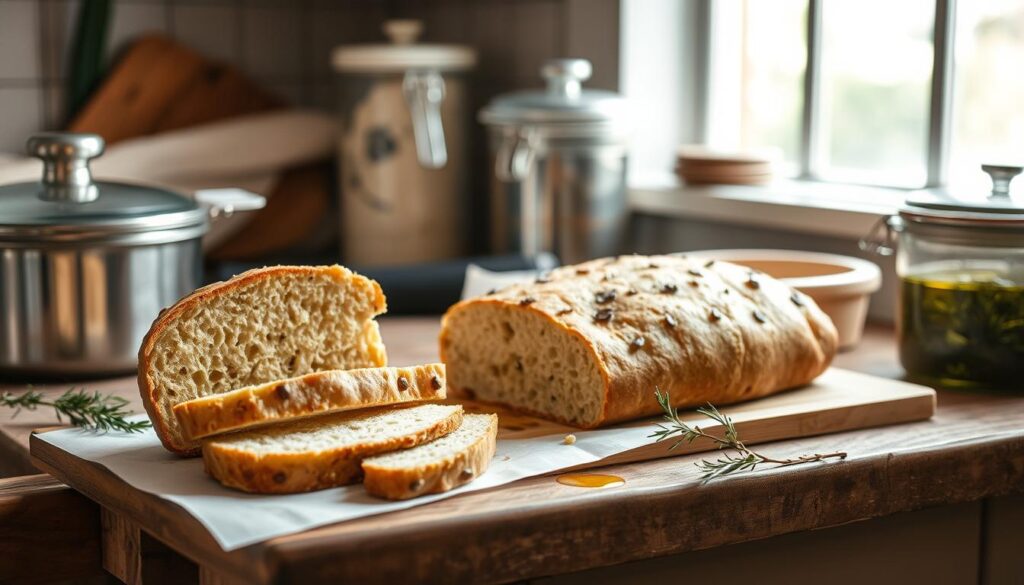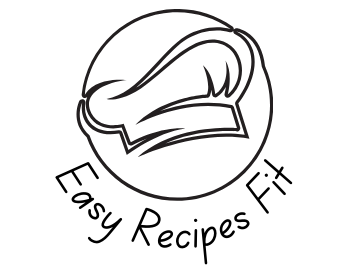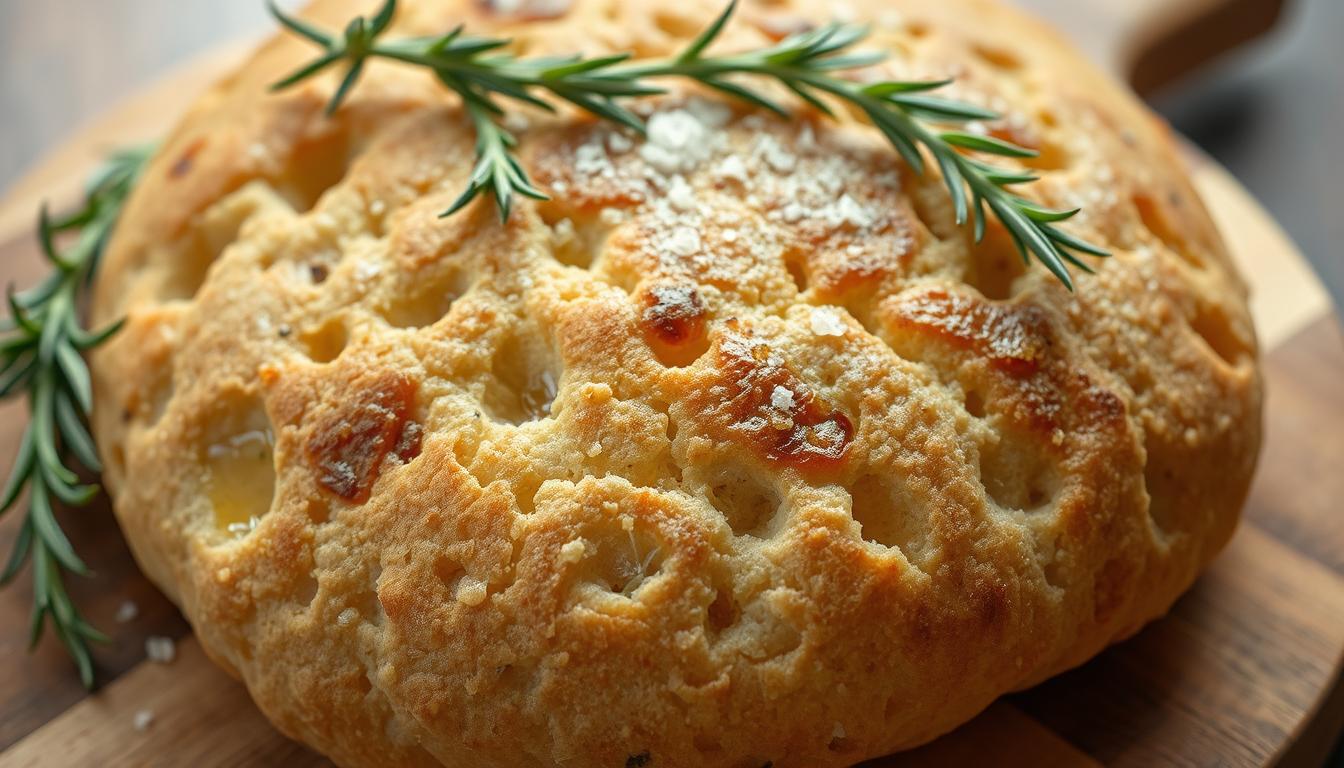The smell of fresh bread is irresistible to me. Discovering overnight focaccia was like finding a secret recipe. It turned my kitchen into a real Italian bakery. This bread is more than a recipe; it connects you to a long history of baking.
Overnight focaccia is simple yet elegant. With a few ingredients and patience, you get a bread that’s crispy outside and soft inside. The dough develops amazing flavors while you sleep.
Whether you’re an experienced baker or just starting, this bread will change how you see bread. The overnight method makes it easy for anyone to make artisan-quality focaccia. It makes bread baking less scary and more fun.
Key Takeaways
- Overnight focaccia requires minimal hands-on time
- Cold fermentation develops deeper flavor profiles
- Home bakers can achieve professional-quality results
- The recipe is versatile and adaptable to various toppings
- No special equipment is required to make exceptional focaccia
Understanding Italian Focaccia: Origins and Traditions
Focaccia is a key part of Italian food, with roots in artisan bread making. It connects today’s kitchens with ancient Mediterranean traditions.
The history of focaccia starts with ancient people who knew the power of simple ingredients. The Etruscans and Romans made early versions of this bread. They laid the groundwork for its importance in Italian food.
Ancient Roots of Focaccia Bread
Focaccia has been around for thousands of years. It started as a simple flatbread baked on hot stones. Its name comes from the Latin word focus, meaning hearth. This shows its deep connection to home and community cooking.
- Originated in ancient Mediterranean civilizations
- Developed by Etruscans and Romans
- Considered a fundamental part of Italian cuisine
Regional Variations in Italian Focaccia
Every Italian region has its own take on focaccia. Liguria is famous for its classic focaccia. It’s known for its golden, dimpled surface and lots of olive oil.
“Focaccia is not just bread, it’s a culinary storyteller of Italian regional diversity.” – Italian Culinary Historian
Traditional Preparation Methods
Making focaccia the old way takes patience and skill. It involves mixing ingredients by hand, slow fermentation, and carefully shaping the dough.
- Hand-mixing traditional ingredients
- Slow fermentation techniques
- Careful stretching and folding of dough
Using these traditional methods, you’ll make a focaccia that links you to Italy’s rich culinary past.
Essential Ingredients for Perfect Focaccia
Creating the perfect yeast bread starts with choosing high-quality ingredients. Your focaccia’s success depends on each component’s role in flavor and texture.
Key ingredients for an exceptional focaccia include:
- All-purpose flour (4 cups)
- Bread flour (1 cup)
- Active dry yeast (2.5 teaspoons)
- Extra virgin olive oil (6 tablespoons)
- Sea salt (5 teaspoons)
- Warm water (2.5 cups)
- Honey or sugar (1 tablespoon)
Let’s explore the critical components for a delicious focaccia. Flour selection is key for the perfect crumb. Mixing all-purpose and bread flour gives a balanced texture.
“The secret to great focaccia lies in the quality of your ingredients.” – Italian Baking Tradition
Your olive oil does more than add flavor. It makes the crumb tender, adds richness, and helps the crust turn golden. Choose a high-quality extra virgin olive oil for the best results.
The yeast is the magic that turns flour, water, and oil into a light, airy bread. Make sure your water is at the perfect temperature (110°F) to activate the yeast.
The Science Behind Overnight Fermentation
Unlocking the magic of no-knead dough involves understanding the intricate science of fermentation. Your focaccia’s extraordinary flavor and texture emerge through a carefully controlled process. This process transforms simple ingredients into a culinary masterpiece.
The overnight fermentation technique transforms yeast dough by creating a slow, cold environment. This environment dramatically enhances bread quality. During this extended resting period, several fascinating scientific processes occur.
Benefits of Cold Fermentation
Cold fermentation offers remarkable advantages for your focaccia:
- Develops deeper, more complex flavor profiles
- Improves gluten network structure
- Enhances bread’s digestibility
- Creates a more tender, airy texture
How Temperature Affects Dough Development
Temperature plays a critical role in fermentation. When you refrigerate your no-knead dough, yeast activity slows down. This allows enzymes to break down starches and proteins more gradually. This process creates subtle flavor nuances impossible with rapid fermentation.
Creating Complex Flavors Through Time
“Time is the secret ingredient in transforming good bread into exceptional bread.” – Artisan Baker
The 8-24 hour refrigeration period enables your yeast dough to develop incredible depth. Slow fermentation produces organic acids. These acids contribute to a more sophisticated taste profile, making your focaccia truly remarkable.
By understanding these scientific principles, you’ll elevate your bread-making from a simple recipe to a sophisticated culinary art form.
Required Kitchen Tools and Equipment
Successful bread baking needs the right kitchen tools. Whether you’re new or experienced, the right tools make baking focaccia easy and fun.
Essential Tools for Bread Baking
- Large mixing bowl (preferably glass or ceramic)
- Sturdy wooden spoon or silicone spatula
- 13×9 inch baking dish
- Measuring cups and spoons
- Kitchen scale (recommended for precise measurements)
Optional but Helpful Equipment
- Dough scraper
- Instant-read thermometer
- Plastic wrap or kitchen towel for covering dough
- Parchment paper
Choose tools that are both quality and functional. A kitchen scale is key for consistent bread. It ensures you measure ingredients right.
| Tool Category | Recommended Type | Price Range |
|---|---|---|
| Mixing Bowl | Large glass or stainless steel | $10-$30 |
| Baking Dish | Non-stick metal or ceramic | $15-$40 |
| Kitchen Scale | Digital with gram/ounce measurement | $20-$50 |
Remember, great equipment doesn’t guarantee perfect bread, but it certainly helps. Choose tools that feel right and match your baking style.
“The right tools transform cooking from a chore into an art.” – Julia Child
Step-by-Step Overnight Focaccia Preparation
Making focaccia is all about precision and patience. The overnight method turns simple ingredients into a tasty, artisan-style bread with little effort.
Making the Initial Dough
To start your no-knead bread adventure, you’ll need these ingredients:
- 360 grams all-purpose flour
- 8 grams kosher salt
- 6 grams instant dry yeast
- 340 grams warm water
- 30 grams olive oil
- 14 grams honey
Proper Storage Techniques
The key to amazing focaccia is cold fermentation. Mix your ingredients, then put the dough in a sealed container in the fridge for 12-48 hours. This slow process brings out deep, complex flavors.
| Storage Parameter | Recommended Value |
|---|---|
| Refrigeration Time | 12-48 hours |
| Container Type | Sealed, oiled container |
| Temperature | Below 40°F |
Morning Preparation Steps
When it’s time to bake, take the dough out of the fridge and let it rest at room temperature for 30 minutes. Pro tip: Use a 9×9-inch baking pan for the perfect focaccia thickness.
“Cold fermentation transforms ordinary ingredients into extraordinary bread.” – Artisan Baker’s Wisdom
Your easy bread recipe is almost ready for baking. Soon, you’ll have a delicious homemade focaccia that will wow your family and friends.
Mastering the Art of Dimpling and Shaping
Making perfect dimpled bread needs a gentle touch and knowing how to shape focaccia. Your fluffy focaccia starts with the dimpling process. It turns simple dough into a culinary work of art.

- Capture olive oil and seasonings
- Create texture variation
- Allow for even baking
- Develop signature focaccia appearance
When making dimpled bread, use damp hands to avoid sticking. Press your fingertips into the dough gently. This creates even divots without deflating the dough.
“Perfect dimpling transforms simple dough into a canvas of culinary art” – Artisan Baking Experts
Your technique should make a dough with gentle depressions. These will hold herbs, oils, and seasonings. Dimples should be 1/4 to 1/2 inch deep. This keeps your focaccia light.
| Dimpling Technique | Best Practices |
|---|---|
| Hand Moisture | Use slightly damp hands to prevent sticking |
| Finger Pressure | Gentle, consistent touch |
| Dimple Depth | 1/4 to 1/2 inch |
| Surface Coverage | Entire dough surface |
Remember, practice makes perfect. Your first try might not be perfect. But each time you make dimpled bread, you’ll get better.
Choosing the Perfect Toppings and Seasonings
Making great olive oil bread is all about picking the right toppings. Your focaccia can go from good to amazing with the right seasonings and ingredients.
Classic Herb Combinations
Traditional focaccia gets a boost from classic herbs. Try these timeless pairs:
- Rosemary and coarse sea salt
- Fresh basil and oregano
- Thyme and cracked black pepper
Creative Topping Ideas
Try new toppings to make your focaccia unique. Here are some tasty options:
- Roasted cherry tomatoes
- Kalamata olives
- Caramelized onions
- Sliced garlic
Salt and Oil Selection
The quality of olive oil and salt matters a lot. Use extra virgin olive oil and high-quality sea salt for the best taste.
| Topping Category | Recommended Options | Flavor Impact |
|---|---|---|
| Herbs | Rosemary, Thyme, Basil | Aromatic, Fresh |
| Vegetables | Cherry Tomatoes, Olives | Intense, Tangy |
| Salt | Flaky Sea Salt, Kosher Salt | Crunchy, Enhancing |
“The secret to an extraordinary focaccia lies in the quality of your ingredients and the creativity of your toppings.”
Baking Techniques for Optimal Results
Mastering bread baking needs precision and knowing the best focaccia techniques. Your path to making crispy bread begins with the right baking method. The secret to amazing focaccia is creating the perfect baking environment. This turns simple ingredients into a memorable dish.
- Preheat your oven to 450°F (232°C) for the best bread baking results
- Place the rack in the oven’s middle for even heat
- Use a heavy-bottomed baking sheet or ceramic dish
“The secret to crispy bread is in the details of baking temperature and technique.” – Professional Baker’s Wisdom
Timing is key when baking focaccia. It should bake for 20-30 minutes, depending on your oven and dough thickness. Look for these signs:
- A golden-brown top surface
- Crispy edges that pull away from the pan
- An internal temperature of 190-210°F, checked with a kitchen thermometer
For the crispiest bread, drizzle extra olive oil around the focaccia’s edges before baking. This adds a delightful texture and boosts the bread’s flavor.
Pro tip: Let your focaccia rest in the baking pan for 10 minutes after baking to get the perfect texture.
Storage and Reheating Guidelines
Keeping your homemade focaccia fresh is key. It’s important to store and reheat it right. This way, your focaccia stays delicious for longer.

Proper Storage Methods
Storing focaccia right keeps it fresh and tasty. Here’s how to keep your bread at its best:
- Store in an airtight container at room temperature for 1-2 days
- Refrigerate in a sealed container for up to 3-4 days
- Freeze sliced focaccia for extended preservation
Freezing Your Homemade Focaccia
Freezing is a great way to keep focaccia for a long time. Here’s how to freeze it:
- Slice the focaccia into individual portions
- Wrap each slice tightly in plastic wrap
- Place wrapped slices in a freezer-safe bag
- Store in the freezer for up to 3 months
Reheating Tips for Fresh-Tasting Focaccia
Here’s how to make your focaccia taste fresh again:
- Thaw frozen focaccia overnight in the refrigerator
- Preheat oven to 300°F (150°C)
- Place unwrapped slices on a baking sheet
- Warm for 5-10 minutes until heated through
Pro tip: A light sprinkle of water before reheating can help restore the bread’s moisture and crispy texture.
By using these tips, your focaccia will taste as good as when you first baked it.
Troubleshooting Common Focaccia Problems
Mastering yeast dough can be tough, even for experts. Focaccia has its own set of challenges that can stop your bread baking journey. Knowing these issues helps you make perfect focaccia every time.
- Dough Not Rising Properly
- Uneven Browning
- Dense Texture
- Soggy Bottom
Diagnosing Dough Issues
Low temperatures can hurt yeast dough. Make sure your proofing area is 85-90°F for best results. Fresh, active yeast is key for great bread.
| Problem | Potential Cause | Solution |
|---|---|---|
| Poor Rise | Old/Inactive Yeast | Replace yeast, verify water temperature (100-108°F) |
| Uneven Browning | Incorrect Oven Temperature | Bake at consistent 450°F, use middle rack |
| Dense Texture | Over-proofed Dough | Limit proofing time, monitor dough volume |
“Patience and precision are the secret ingredients in successful bread baking.” – Professional Baker’s Wisdom
Working with focaccia dough needs careful attention to protein content. King Arthur Bread Flour, with 12.7% protein, is better than all-purpose flour for structure.
Key Recommendations
- Use a kitchen scale for precise measurements
- Check yeast freshness regularly
- Monitor dough temperature
- Avoid overloading toppings
Every baking challenge is a chance to get better. Keep practicing, observing, and tweaking your method with each focaccia try.
Creating Focaccia Variations and Flavor Combinations
Italian cuisine lets you get creative with focaccia, turning it into a canvas for new flavors. By trying different toppings and flavors, your olive oil recipes can become truly special.
- Savory Mediterranean-Inspired Toppings
- Kalamata olives
- Sun-dried tomatoes
- Crumbled feta cheese
- Fresh thyme leaves
- Sweet Focaccia Variations
- Caramelized apple and cinnamon
- Honey and lavender
- Roasted pears with walnuts
Pro tip: Spread toppings evenly to ensure they bake well and soak up flavors. Light toppings are best to keep the dough light.
“Focaccia is not just bread—it’s an edible art form waiting for your personal touch!” – Italian Bread Master
For great focaccia, keep the dough hydrated right. Aim for 65-86% water to get that light, airy feel.
Some top topping combos include:
- Rosemary and sea salt classic
- Caramelized onion and goat cheese
- Cherry tomato and basil
- Roasted garlic and herb
Choose small toppings for best results. Big, wet toppings can make the bread soggy and prevent it from rising right.
Conclusion
Your journey into easy homemade bread has just started with overnight focaccia. This method makes creating artisan bread simple and fun. It lets you make rich, complex flavors with little effort.
Overnight focaccia is easy and versatile. It’s perfect for both new and experienced bakers. With just a few ingredients like bread flour and olive oil, you can make a delicious bread that will wow everyone.
Keep practicing to get better at bread baking. Each time you make overnight focaccia, you’ll learn something new. Try different toppings and herbs to make your bread even better. The joy of pulling a golden focaccia from the oven is unmatched.
Enjoy the slow fermentation process and the delicious results. Your kitchen will fill with amazing smells and tastes. All thanks to the simple magic of overnight focaccia.
FAQ
What is overnight focaccia?
Overnight focaccia is a traditional Italian bread. It’s made by preparing the dough the night before. Then, it rises slowly in the fridge.
This method boosts the bread’s flavor and texture. It also makes baking easier for home cooks.
Do I need special equipment to make overnight focaccia?
You don’t need special tools, but a few are helpful. You’ll need a big mixing bowl, a baking sheet, parchment paper, and plastic wrap.
A stand mixer can be useful, but it’s not required. You can mix the dough by hand if you prefer.
How long does overnight focaccia take to prepare?
It takes about 12-16 hours to prepare. Most of this time is spent waiting for the dough to ferment.
It only takes 15-20 minutes to start. Then, it rests in the fridge overnight. Finally, it proofs and bakes for 1-2 hours the next day.
Can I freeze overnight focaccia?
Yes, you can freeze focaccia for up to 2-3 months. Wrap it in plastic wrap and then foil.
To reheat, thaw it at room temperature. Then, warm it in a 350°F oven for 5-10 minutes to get it crispy again.
What are the best toppings for focaccia?
Classic toppings include rosemary, sea salt, and olive oil. You can also try sliced olives, cherry tomatoes, caramelized onions, and fresh herbs.
For something sweet, try chocolate and sea salt. Use high-quality ingredients to enhance the bread’s flavor.
Is overnight focaccia difficult to make?
No, it’s very easy! Overnight focaccia is a simple recipe for beginners. The slow fermentation does most of the work.
Even if you’re new to baking, you can get great results with little effort.
Can I make focaccia without a stand mixer?
Absolutely! You can mix the dough by hand. Use a big bowl and a wooden spoon or spatula.
The no-knead method means you just mix until combined. Then, let it rest in the fridge to develop flavor and texture.
What type of flour works best for focaccia?
Bread flour or all-purpose flour are best. They create the bread’s chewy texture.
Some bakers mix all-purpose and whole wheat flour for extra nutrition and complexity.
How can I tell if my focaccia dough is properly fermented?
Look for a dough that’s doubled in size and puffy. It should have small bubbles on the surface.
When you press it gently, it should spring back. If it’s dense or hasn’t grown, it needs more time.
What makes overnight focaccia different from regular focaccia?
The main difference is the slow, cold fermentation. Overnight focaccia has deeper flavors because of this.
The cold temperature helps yeast work slower. This results in a more complex taste compared to quick-rise breads.

